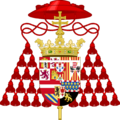Cardinal-Infante Ferdinand of Austria facts for kids
Quick facts for kids Infante Ferdinand |
|
|---|---|
| Cardinal-Deacon of Santa Maria in Portico | |
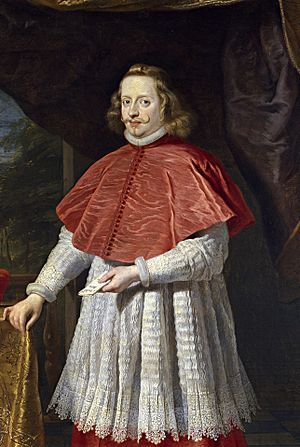
Portrait by Gaspar de Crayer, 1639
|
|
| Enthroned | 29 July 1619 |
| Reign ended | 9 November 1641 |
| Predecessor | Ferdinando Gonzaga |
| Successor | Virginio Orsini |
| Other posts | Apostolic Administrator of Toledo Governor of the Spanish Netherlands Governor of the Duchy of Milan |
| Orders | |
| Created Cardinal | 29 July 1619 |
| Rank | Cardinal-Deacon |
| Personal details | |
| Born | 16 May 1609 San Lorenzo de El Escorial, Kingdom of Spain |
| Died | 9 November 1641 (aged 32) Brussels, Spanish Netherlands |
| Buried | El Escorial |
| Denomination | Catholic |
| Parents | Philip III of Spain Margaret of Austria |
Cardinal-Infante Ferdinand (born May 1609 or 1610 – died November 9, 1641) was a Spanish prince. He was known as an Infante (a royal prince) and a Cardinal in the Catholic Church. This is why he was called "Cardinal-Infante."
Ferdinand also served as the Governor of the Spanish Netherlands. He was an Archbishop of Toledo and a skilled general. He played an important role in the Thirty Years' War and the Franco-Spanish War.
Contents
Who Was Cardinal-Infante Ferdinand?
Ferdinand was born in 1609 at El Escorial near Madrid, Spain. His father was King Philip III of Spain and Portugal. His mother was Margaret of Austria. She was the sister of Emperor Ferdinand II.
Ferdinand's older siblings included King Philip IV of Spain and Anne of Austria, who became the Queen of France.
Becoming a Cardinal and Archbishop
Ferdinand's father wanted him to have a career in the church. So, in 1619, Ferdinand became the Archbishop of Toledo. This was a very important religious position in Spain. Soon after, he was made a Cardinal.
The title "Cardinal-Infante" showed his high rank. It combined his role as a Cardinal with his status as a royal prince of Spain.
Ferdinand's Military Adventures
In 1630, Ferdinand's aunt, Isabella Clara Eugenia, wanted him to become the next governor of the Spanish Netherlands. To travel there safely, he needed a large army. Traveling by sea was too risky because of the ongoing war with the Dutch navy.
So, in 1633, Ferdinand went to Genoa. He had just finished his role as governor of Catalonia. He met with an army from Milan to march through Europe. This route was called the Spanish Way. It went through Lombardy, Tyrol, and Swabia. Then it followed the Rhine River to the Netherlands.
Marching to Nördlingen
Ferdinand also planned to protect this supply route with military bases. He wanted to support the army of his brother-in-law, King Ferdinand III of Hungary. King Ferdinand was leading the Imperial army against the Swedes in the Thirty Years' War.
Ferdinand's journey was delayed by illness. He sent half of his army ahead. This part of the army was led by the Duke of Feria. However, this army suffered heavy losses fighting the Swedish army.
The Spanish asked for help from another general, but they were refused. So, the Spanish had to pay for more troops themselves. In 1634, Cardinal-Infante Ferdinand continued his journey. He gathered the remaining soldiers from the Duke of Feria's army in Bavaria. The Duke of Feria had died earlier that year.
The Battle of Nördlingen (1634)
Meanwhile, Ferdinand of Hungary defeated the Swedish army in July 1634. Cardinal-Infante Ferdinand and his cousin, Ferdinand of Hungary, then rushed to combine their armies. The Swedish forces tried to stop them but failed.
In September 1634, both armies successfully joined together. They camped south of Nördlingen in Swabia. Nördlingen was a town protected by a small Swedish army. Soon after, the main Swedish armies arrived, setting the stage for a major battle.
Cardinal-Infante Ferdinand and his cousin prepared for battle. They did not listen to advice from more experienced generals. The Swedish commanders also prepared for battle, but they disagreed with each other. They also underestimated the size of the enemy forces. They thought the Spanish army was much smaller than it was.
During the battle, many things went wrong for the Swedish forces. The Spanish infantry fought very well. The two Ferdinands won a great victory. The Swedish army that escaped was much smaller than before.
Governing the Spanish Netherlands
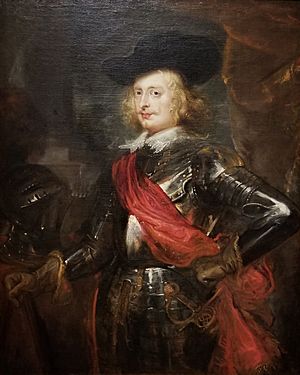
After the battle, Ferdinand of Hungary wanted his cousin to stay and strengthen their hold on Germany. But Cardinal-Infante Ferdinand moved his troops to Brussels almost immediately. He arrived in Brussels at the end of 1634 as a celebrated Governor-General.
Ferdinand was a skilled politician and diplomat. He quickly improved the government and the military. He especially managed to gain the support of the people in Flanders against France. However, his power was secretly limited. The leader of his army was told to follow Spanish orders, not Ferdinand's, if needed.
Military Campaigns in the Netherlands
In 1635, the French attacked Namur. They planned to join forces with the Dutch army. But Ferdinand's strong defenses stopped them. At the siege of Leuven, the French and Dutch forces faced many problems. They had little supplies and many soldiers got sick or left. They had to retreat when a Spanish relief force arrived.
This allowed Ferdinand's Spanish forces to attack. They pushed back the Dutch and forced the French to retreat. Ferdinand then captured several towns, including Diest, Goch, and Schenkenschanz.
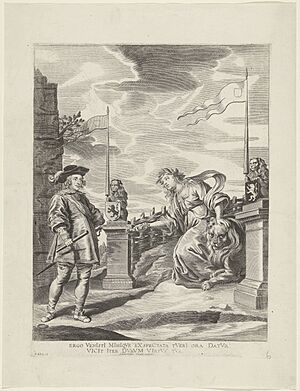
In 1636, Ferdinand removed the last Protestant priests in the Spanish Netherlands. He continued his military attacks. He captured more towns and secured Luxembourg. His forces even reached as far as Corbie in France, which threatened Paris.
In 1637, Spanish forces were busy fighting the French. This left Breda less protected. The Dutch recaptured it after a three-month siege. This was a blow to Spain's reputation. However, Ferdinand gained more important towns that year. He took Venlo and Roermond in the Meuse valley. This cut off Maastricht from the Dutch Republic. It also stopped further Dutch attacks on the Spanish Netherlands from the east.
In 1638, Ferdinand's army successfully defended Antwerp, Saint-Omer, and Geldern from the Dutch and French armies. Ferdinand won a great victory over the Dutch at the Battle of Kallo. He wrote to his brother, the King of Spain, calling it "the greatest victory which your Majesty's arms have achieved since the war in the Low Countries began."
In 1639, Ferdinand again stopped French and Dutch plans. The Dutch navy destroyed an important Spanish fleet. But it failed to stop most of the Spanish army from landing at Dunkirk. While Ferdinand stopped the Dutch from attacking Hulst, another Spanish army destroyed the main French army in the south.
In 1640, Dutch attacks on Hulst and Bruges were stopped by the local Spanish forces. In the south, the French army launched a big attack on Arras. Ferdinand took command of the army but could not break the French lines. The city finally surrendered on August 9. This was the first major French victory in the war after five years of fighting.
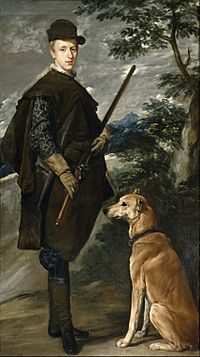
Ferdinand's Final Years
Ferdinand faced challenges not just from his military enemies, but also from people at the Spanish court. Rumors spread that he was planning to become an independent ruler of the Spanish Netherlands. These rumors were not true.
The Spanish empire was under great military and financial pressure. Ferdinand was even given confusing orders to send troops to Spain. This was to help against a rebellion in Portugal in 1640.
Death and Legacy
Ferdinand became ill during battles in 1641. He died on November 9, 1641, in Brussels at age 32. People thought he died from exhaustion and poor health. Some reports mentioned a stomach ulcer. However, there were also rumors that he was poisoned.
Before his death, he had a daughter named Marie Anne de la Croix. She was born in Brussels in 1641 and later became a nun in Madrid.
Ferdinand's body was brought to Spain in 1643. Many religious services were held for him, as he had wished. He was buried in the Panteón de Infantes, a royal burial place.
After his death, there were disagreements about who should replace him as Governor-General. These disputes weakened the alliance between the Emperor and Spain.
Images for kids
See also
 In Spanish: Fernando de Austria (cardenal-infante) para niños
In Spanish: Fernando de Austria (cardenal-infante) para niños





